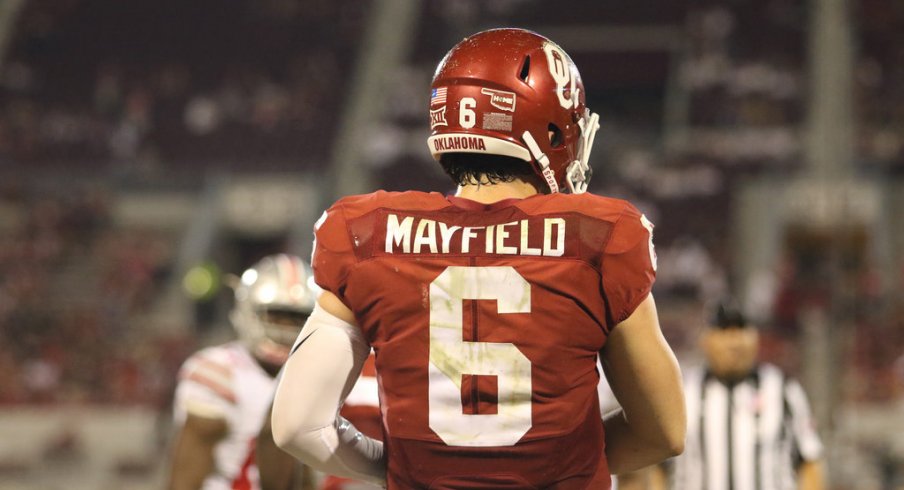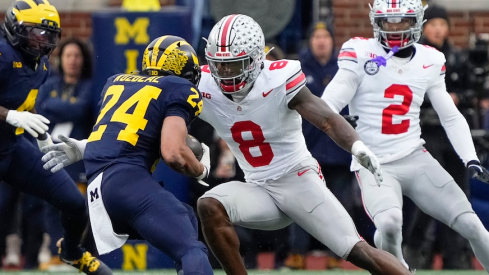Bob Stoops probably doesn't get enough credit.
Though the former Sooner coach cut his teeth as a defensive assistant, leading units for Bill Snyder and Steve Spurrier before getting the opportunity to lead a program of his own in the late 90s, his offenses in Norman always seemed to be on the cutting edge. While many coaches would've opted to hire a more conservative play-caller as he tried to turn around a traditional powerhouse like Oklahoma, Stoops shocked everyone by hiring Mike Leach to install the Air Raid in his first season.
Though Leach would leave shortly after to run a program of his own for the first time at Texas Tech, the effects of that hire on Stoops' program are still felt today. Many of Leach's core passing concepts would later be combined with those of another Sooner play-caller - Kevin Wilson - to create the powerhouse offense that featured Sam Bradford and Adrian Peterson a decade ago.
But after a spell in the early part of this decade in which the Sooners failed to consistently find a balance between the run and the pass, Stoops called on one of the proteges of his first coordinator, a former Texas Tech quarterback named Lincoln Riley. After walking on and backing up stars like Kliff Kingsbury and BJ Symons in Lubbock, Riley quickly worked his way up the assistant ranks under Leach before following Ruffin McNeil to East Carolina to call plays for the first time.
Once given an offense of his own to lead, Riley wasn't afraid to run the ball far more often than Leach had, which made his resume far more interesting when Stoops came calling in 2015. At the time, the Sooners had two extremely talented backs on the roster in Simaje Perine and Joe Mixon, but no clear vision for the passing game, leaving Stoops without the balance he desired.
With Riley at the helm, Baker Mayfield quickly ascended the depth chart, having been familiar with the Air Raid from a lone season playing at Tech under Kingsbury. To account for his three most gifted offensive players all needing to line up in the backfield, though, Riley adjusted many of his base passing schemes to resemble those of early 1980s offenses, such as BYU's split-back attack from Lavell Edwards and Norm Chow that inspired Leach and Hal Mumme to create the Air Raid in the first place.
The results were obviously electrifying, as the Sooners made the College Football Playoff in Riley's first season in Norman. After finishing second in the nation in total offense last fall, it seemed obvious who was the best candidate to replace Stoops after he suddenly announced his retirement earlier this year.
But though Riley is now leading the program, he's still tasked with leading the offense this fall, and the pieces at his disposal are quite different despite Mayfield's return for a fifth and final season.
Though Perine and Mixon are gone, the running game with tailback Abdul Adams still seems capable of moving the sticks, thanks in large part to one of Riley's signature schemes - the GT Counter-Read:
Without needing to get two backs on the field as often as possible, Riley and Mayfield are able to find their true Air Raid roots with four players often split out at once. However, the GT Counter-Read allows them to spread the defense out wide and still run the ball behind their massive line, thanks in large part to Mayfield's ability to hold a backside defender and pick up yards with his legs if need be.
But just because the Sooners go four-wide, it doesn't mean they're just trotting out four little receivers. Instead, Riley's offense often operates with 12 personnel (1 back, 2 tight ends), with fullback/tight end Dimitri Flowers and flex tight end Mark Andrew lining up everywhere - from the slot to the backfield - depending on the play. This versatility allows Riley to send out the same, base personnel with two traditional receivers and a traditional tailback joining Flowers and Andrews before calling anything from a lead-zone run play from an I-formation to a four-wide Air Raid pass.
Andrews, specifically, has become the new star of Riley's versatile scheme. The 6'5" 250 lb former receiver emerged as Mayfield's favorite target in week one, hauling in 7 passes for 134 yards and a touchdown against UTEP.
But unlike most Air Raid schemes that line up the same receivers in the same place on every play, allowing defenses to build their schemes around those fixed positions, Andrews is the queen on the chess board thanks to his athleticism. Though he's the most sure-handed receiver on the field, he's also a capable blocker, easily hiding as an inline tight end before releasing on downfield play-action throws.
Of course, it certainly helps when he has a quarterback as accurate as Mayfield to get him the ball. The senior from Texas led all returning QBs in Pro Football Focus' adjusted completion rate last year, which removes throwaways, drops, and throws while getting hit, and continued that trend into this season, going a remarkable 19-20 for 329 yards and 3 touchdowns in the opener.
With so many pieces at his disposal, Riley's puzzle has become that much harder for opposing defenses to solve. In last fall's matchup with the Buckeyes, Greg Schiano played his base, 4-3 defense for most of the game, willing to pit his linebackers against Perine and Mixon. But it's unclear how, exactly, he plans to slow down Andrews.
Should the Buckeyes play the same man-coverage they showed against Indiana, outside linebackers Jerome Baker and Dante Booker would often be left on an island against Andrews - a matchup that favors the Sooners. Instead, it's far more likely that we see the 'Quarters' coverage installed by Schiano's predecessor, Chris Ash, in an effort to contain Andrews as well as keep eyes on the backfield knowing Mayfield's ability to run.
Whatever the coverage, though, Ohio State dominated last year's contest thanks to their ability to win the battle in the trenches on both sides of the ball. Against the high powered Sooner offense, Larry Johnson's rushmen must be able to penetrate and force Mayfield into early throws, just as they did last fall.
But though the solution to beating the Sooners may be the same, one thing is clear - the challenge of stopping the Oklahoma offense in 2017 is far different than it's been in the past.



